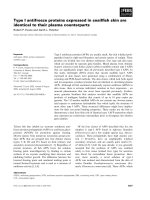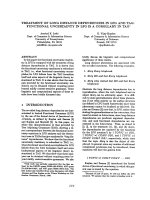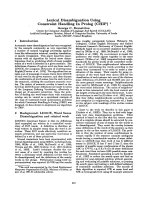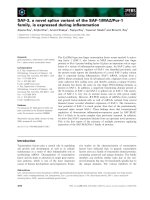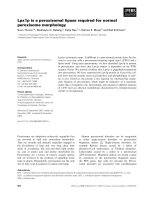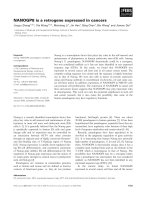Báo cáo khoa học: NANOGP8 is a retrogene expressed in cancers pdf
Bạn đang xem bản rút gọn của tài liệu. Xem và tải ngay bản đầy đủ của tài liệu tại đây (325.54 KB, 8 trang )
NANOGP8 is a retrogene expressed in cancers
Jingyu Zhang
1,2,
*, Xia Wang
1,2,
*, Meixiang Li
1
, Jin Han
1
, Bing Chen
1
, Bin Wang
1
and Jianwu Dai
1
1 Laboratory of Molecular and Developmental Biology, Institute of Genetics and Developmental Biology
,
Chinese Academy of Sciences,
Beijing, China
2 The Graduate School, Chinese Academy of Sciences, Beijing, China
Nanog is a recently identified transcription factor that
plays key roles in self-renewal and maintenance of plu-
ripotency in inner cell mass and embryonic stem (ES)
cells [1–3]. It is generally believed that the Nanog gene
is specifically expressed in human ES cells and germ
lineage cells and its expression may be controlled by
an interaction between OCT4 and other proteins
through an adjacent pair of highly conserved Octamer-
and Sox-binding sites of 5¢-flanking region of Nanog
[4,5]. Nanog expression is rapidly down-regulated dur-
ing ES cell differentiation, and constitutive expression
of Nanog gene inhibits ES cell differentiation [3]. The
regulation of Nanog gene expression and the nature of
its target genes emerged as central issues in pluripotent
stem cell biology [2].
Pseudogenes are common in mammalian genomes
such as human and mouse and are defined as inactive
versions of functional genes, i.e. they do not produce
functional, full-length protein [6]. There are about
20 000 pseudogenes in human genomes [7]. It has been
hypothesized that pseudogenes, especially those that are
transcribed, have regulatory roles because of their high
level of sequence similarities and conservation [8–10].
Recently, pseudogenes have been speculated to be
involved in the epigenetic regulation of gene activities
[11]. It is interesting that human Nanog has unusually
high number of pseudogenes, 11 in total [12,13]. Among
them, NANOGP8 is theoretically unique since it has a
complete open reading frame and an Alu element in the
3¢-UTR which is homologous to that of Nanog. The
possibility that NANOGP8 may be a retrogene rather
than a pseudogene was entertained, but was considered
unlikely as NANOGP8 has not been identified in any
expressed sequence tags (ESTs) [12].
In the current study, we found NANOGP8
expressed in several cancer cell lines and all the cancer
Keywords
Nanog; NANOGP8; pseudogene; retrogene;
tumorigenesis
Correspondence
J. Dai, Laboratory of Molecular and
Developmental Biology, Institute of
Genetics and Developmental Biology,
Chinese Academy of Sciences, Beijing,
China.
Tel ⁄ Fax: +86 010 82614426
E-mail:
*The authors contributed equally to this
work.
(Received 11 November 2005, revised 26
January 2006, accepted 20 February 2006)
doi:10.1111/j.1742-4658.2006.05186.x
Nanog is a transcription factor that plays key roles in the self-renewal and
maintenance of pluripotency in human embryonic stem (ES) cells. Among
Nanog’s 11 pseudogenes, NANOGP8 theoretically could be a retrogene,
but was considered unlikely as it has not been identified in any expressed
sequence tags (ESTs). In this study, we found that NANOGP8 was
expressed in several cancer cell lines and in all cancer tissues tested. The
complete coding sequence was cloned and the sequence is highly homolog-
ous to that of Nanog. We were also able to detect its protein expression
using anti-Nanog antibody in recombinant Escherichia coli and some can-
cer cell lines tested. In addition, expression of NANOGP8 in NIH3T3 cells
can promote cell proliferation. The expression of NANOGP8 in cancer cell
lines and cancer tissues suggests that NANOGP8 may play important roles
in tumorigenesis. This work not only has potential significance in stem cell
and cancer research, but it also raises the possibility that some of the
human pseudogenes may have regulatory functions.
Abbreviations
ES, embryonic stem; ESTs, expressed sequence tags; MTT, 3-(4,5-dimethylthiazol-2-yl)-2,5-diphenyl tetrazolium bromide.
FEBS Journal 273 (2006) 1723–1730 ª 2006 The Authors Journal compilation ª 2006 FEBS 1723
tissues tested. No expression was detected in primarily
cultured fibroblasts. At the same time, NANOGP8
was shown to prompt cell proliferation. These data
indicated that NANOGP8 might play important roles
in tumorigenesis.
Results
NANOGP8 is transcribed in cancer cell lines and
tumor tissues
Human Nanog pseudogenes comprised 10 processed
pseudogenes and one tandem duplicate [12]. Certain
regions of these pseudogenes were highly conserved.
The coding regions of 70% of Nanog pseudogenes
share about 90% sequence identity [13]. Sequence com-
parison of the mRNA revealed the presence of the
5¢-UTR sequence in Nanog, which is absent from
other Nanog pseudogenes. We used this feature to dis-
criminate Nanog and its pseudogenes.
NANOGP8 lied in chromosome 15 and shares the
greatest similarity to Nanog. It contains a complete
open reading frame, which might be transcribed in
physiological conditions. To determine whether
NANOGP8 could be transcribed, we designed human
Nanog specific primers based on its 5¢-UTR, and the
expected PCR product is 444 basepairs. We also
designed a pair of universal primers that would amplify
NANOGP8, Nanog, and Nanog’s other pseudogenes
due to their homology, and the expected PCR product
is 403 basepairs. Figure 1 showed the lack of expres-
sion of Nanog and its pseudogenes in normal human
primarily cultured fibroblasts; Nanog was expressed in
ovary teratocarcinoma cell line PA-1 and testicular
embryonic carcinoma NTERA-2, and sequencing
the 444 basepairs PCR product confirmed the findings
(Table 1). Furthermore, when the PCR products were
cloned and sequenced, the results indicated that
NANOGP8 was expressed in human osteosarcoma cell
line OS732, human hepatoma cell line HepG2 and
human breast adenocarcinoma cell line MCF-7
(Table 1). At the same time, other pseudogenes were
found in OS732, HepG2 and MCF-7, while Nanog
gene was also expressed in HepG2 and MCF-7 but not
in OS732 (Table 1 and Fig. 1). In this study, we found
that NANOGP8 was transcribed in all of the human
cancer tissues tested (Table 1 and Fig. 2) as well as
in several cancer cell lines. In contrast, Nanog and
NANOGP8 were not expressed in normal primarily
cultured fibroblast cell line or fetal liver epithelium
cells (data not shown). It is interesting that only
NANOGP8 was expressed in OS732 cell line, uterine
cervix and breast tumor tissues, while Nanog gene was
undetectable (Table 1). Thus, it is true that NANOGP8
was transcribed in cancer cell lines and tumor tissues.
Fig. 1. Detection of Nanog, NANOGP8 and other pseudogenes in
tumor cell lines. RT-PCR analysis the expression of Nanog,
NANOGP8 and other pseudogenes in human fibroblasts and tumor
cell lines OS732, HepG2, MCF-7, THP-1, HeLa, PA-1 and NTERA-2.
Sequencing analysis of PCR products (Table 1) confirmed that
NANOGP8 was expressed in cell lines OS732, HepG2, and MCF-7
while Nanog was expressed in HepG2, MCF-7, PA-1 and NTERA-2.
No-RT data were also shown.
Table 1. The sequencing results of RT-PCR product (403 basepairs)
clones with the universal primers.
Cells or
tissues
tested
Total
sequenced
clones
Sequenced
clones of
Nanog
Sequenced
clones of
NANOGP8 Others
Normal cells
Human
fibroblasts
0000
Tumor cell lines
OS732 13 0 5 6(NANOGP4)
2(NANOGP5)
HepG2 12 2 3 6(NANOGP4)
1(NANOGP5)
MCF-7 15 2 2 3(NANOGP4)
8(NANOGP5)
THP-1 0 0 0 0
HeLa 0 0 0 0
Teratocarcinoma cell lines
PA-1 7 7 0 0
NTERA-2 6 6 0 0
Tumor tissues
Uterine cervix 5 0 1 1(NANOGP2)
2(NANOGP4)
1(NANOGP7)
Breast 13 0 8 1(NANOGP4)
1(NANOGP5)
3(NANOGP7)
Urinary bladder 8 1 4 1(NANOGP2)
2(NANOGP7)
NANOGP8 is a retrogene expressed in cancers J. Zhang et al.
1724 FEBS Journal 273 (2006) 1723–1730 ª 2006 The Authors Journal compilation ª 2006 FEBS
NANOGP8 complete coding sequence was
obtained from urinary bladder cancer
Using RT-PCR, the complete coding sequence of
NANOGP8 was cloned from urinary bladder cancer
tissues and its sequence was found to be highly homol-
ogous to Nanog. There are six alternations over 918
sites (Fig. 3 and Supplementary material Fig. 1) and
only one change in the inferred amino acid sequence
from 253 Gln in Nanog to His in NANOGP8. Thus, it
is likely that NANOGP8 and Nanog genes have sim-
ilar functions.
NANOGP8 and ⁄ or Nanog protein was detected
in cell lines
The expression levels of NANOGP8 appear relatively
low in the cancer cell lines and neoplastic tissues
compared to Nanog in EC cells (Figs 1 and 2). Given
the very high degree of homology between Nanog and
NANOGP8 on the basis of nucleotide sequences, it is
likely that the commercially available Nanog antibod-
ies could recognize NANOGP8-translated protein. To
confirm this hypothesis, we first constructed GST-
NANOP8 fusion protein expressed in recombinant
Escherichia coli and then detected NANOP8 using
anti-Nanog antibody. Nanog antibody could recognize
the fusion protein (60 kDa) (Fig. 4B). To directly
examine NANOGP8 protein expression, nuclear pro-
tein extracts were used for western blot assay. Accord-
ing to Table 1 and Fig. 1, both NANOGP8 and
Nanog were transcribed in HepG2, while Nanog was
not transcribed in OS732. Thus, it is likely the protein
of NANOGP8 and ⁄ or Nanog was detected in cancer
line HepG2 and the protein of NANOGP8 was found
in cancer line OS732 using anti-Nanog antibody and
the observed molecular weight (34 kDa) of the pro-
tein was consistent with its predicted full-length
sequence (Fig. 4A). Therefore, the above findings
Fig. 2. Detection of Nanog, NANOGP8 and other pseudogenes in
tumor tissues. RT-PCR analysis of Nanog, NANOGP8 and other
pseudogenes expression in human fibroblasts and human carci-
noma tissues of the uterine cervix, breast and urinary bladder is
shown. NANOGP8 was expressed in all of the human cancer tis-
sues that were tested. NANOGP8 was not expressed in human
fibroblasts. Nanog was expressed in urinary bladder tumor tissues
and PA-1 cell lines. No-RT data were also shown.
Fig. 3. Sequence alignment of human Nanog and NANOGP8
genes. The differences in nucleotides and their positions are
shown. The translational start site is defined as +1. There is only
one change in the inferred amino acid sequence from Gln
(CAG759) in Nanog to His (CAC759) in NANOGP8.
A
B
Fig. 4. Western blot detection of NANOG and ⁄ or NANOGP8 pro-
tein. Detection of NANOGP8 protein in (B) E. coli (1) and E. coli
with NANOGP8 (2) and NANOGP8 in (A) OS732 and Nanog or
NANOGP8 in MCF-7 and HepG2 using anti-Nanog antibody. The
lack of expression of both Nanog and NANOGP8 in human fibro-
blasts is also shown. Actin (43 kDa) was used as loading control.
J. Zhang et al. NANOGP8 is a retrogene expressed in cancers
FEBS Journal 273 (2006) 1723–1730 ª 2006 The Authors Journal compilation ª 2006 FEBS 1725
showed that NANOGP8 was translated and it sugges-
ted NANOGP8 is a retrogene but not a pseudogene.
NANOGP8 was localized in the nuclei
of transfected cells
Human Nanog is a transcriptional regulator and is
localized in the nucleus [2,3]. Due to the high homol-
ogy between Nanog and NANOGP8, NANOGP8 is
likely a nuclear protein as well. To confirm this, we
constructed a NANOGP8 and GFP fusion protein. As
shown in Fig. 5, the fusion protein was localized in the
nuclei of transfected NIH3T3 (Fig. 5 A and 5B), while
GFP in the control group was present diffused in the
cytoplasm (Fig. 5C,D). Therefore, NANOGP8 is also
a nuclear protein.
NANOGP8 promotes cells to enter into S phase
Cell cycle analysis was performed in NANOGP8 trans-
fected NIH3T3 (pQCXIN-NANOGP8 vector) and
mock control (pQCXIN vector) by flow cytometry
(Fig. 6A). The percentage of S phase in NANOP8-
transfected cells was 53.3%, which was higher in
comparison with the mock control (46.5%). The
difference was statistically significant (P<0.05). The
results were obtained from three independent clones.
These results indicate that expression of exogenous
NANOGP8 gene promotes cells to enter into S phase
of the cell cycle.
NANOGP8 promotes cell proliferation
The increase in the percentage of cells in S phase sug-
gests that NANOGP8 may promote cell proliferation
[14]. To confirm this, we examined the effect of
NANOGP8 overexpression on NIH3T3 cell growth.
The results of 3-(4,5-dimethylthiazol-2-yl)-2,5-diphenyl
tetrazolium bromide (MTT) assay (Fig. 6B) indicated
that the proliferation rate of NANOGP8-transfected
cells was significantly increased.
Discussion
Pseudogenes are thought to be ‘molecular fossils’,
which can be used as a model to study the rate of nuc-
leotide substitution, insertion and deletion in genome
[15]. Recent experimental data have indicated that
Fig. 5. Nuclear location of NANOGP8-GFP.
The NANOGP8-GFP (A,B) and GFP (C,D)
vector were introduced into NIH3T3,
respectively, and photographed in bright
fields and fluorescent field (B,D) and
merged photos (A,C).
NANOGP8 is a retrogene expressed in cancers J. Zhang et al.
1726 FEBS Journal 273 (2006) 1723–1730 ª 2006 The Authors Journal compilation ª 2006 FEBS
some pseudogenes were transcribed and might be func-
tionally active [9,10]. On the other hand, great care
must be taken in validation of some assays for inter-
vention of pseudogenes [16].
Nanog is a recently identified transcriptional factor
that plays important role in regulating pluripotency
and self-renewal of ES cells [2,3]. Recently, Nanog’s 11
pseudogens were identified, including 10 processed
pseudogenes and one tandem duplicate [12]. They
share sequence homology to the Nanog coding region,
but lack the potential to produce a functional protein
except the NANOGP8 because of critical mutations
[12]. NANOGP8, bearing close similarity to Nanog,
theoretically could be a retrogene, but this was consid-
ered unlikely as it has not been identified in any ESTs.
The EST database provides tremendous gene expres-
sion information from many types of tissues or cells.
Theoretically any gene transcriptions could be found.
We carried out an EST search, where we found it is
difficult to distinguish Nanog from NANOGP8 in
some ESTs (Supplementary material Fig. 2). This
maybe because of the limitation of each clone’s
sequence information in EST database and the high
similarity between NANOGP8 and Nanog, with only
six nucleotides alternations and one amino acid muta-
tion being found between them. In addition,
NANOGP8 expression is extremely low compared with
that of Nanog and this might contribute at least parti-
ally to why NANOGP8 ESTs have not been detected
from human cancers and cancer cell lines.
To investigate whether NANOGP8 could be tran-
scribed, we designed human Nanog-specific primers
and also designed a pair of primers that would amplify
NANOGP8, Nanog, and Nanog’s other pseudogenes
due to their homology. By using these primers for
PCR analysis and DNA sequencing, we would be able
to identify the transcribed pseudogenes. Our results
showed the lack of expression of NANOGP8 and
Nanog in normal human primarily cultured fibroblasts,
fetal liver epithelium cells (data not shown). Further-
more, when all the PCR products were sequenced, the
results confirmed that NANOGP8 was expressed in
HepG2, MCF-7, OS732 as well as all the human can-
cer tissues tested.
In addition, we have obtained the complete
NANOGP8 coding region from cancer tissues by RT-
PCR excluding the genomic DNA contamination.
Analysis of the nucleotide sequences in Nanog and
NANOGP8 demonstrated that there are six alterna-
tions, which resulted in only one amino acid change in
the predicted protein sequence from (Gln, 757CAG)
in Nanog and (His, 757CAC) in NANOGP8. Since
NANOGP8 has an intact open-reading fragment, so it
has the potential to encode a full protein. We then
expressed NANOGP8 in E. coli, which could be detec-
ted by western blot after GST affinity purification. Fur-
ther, anti-Nanog antibody can recognize translated
NANOGP8 protein in OS732. These data suggested
that NANOP8 is a retrogene rather than a pseudogene.
Because cancer cells and stem cells share many com-
mon characters, such as unlimited proliferation, it has
been suggested that similar mechanisms might be
involved in regulating cancer cells and stem cells [17].
Our preliminary results showed that forced expression
of Nanog gene in 3T3 fibroblasts could greatly increase
cell proliferation rate [18]. When NANOGP8 was sta-
bly transfected into NIH3T3 cells, the cells were pro-
moted to enter into the S stage and, at the same time,
MTT growth assay showed increased cell proliferation.
Our findings that NANOGP8 is expressed in cancer
cell lines and cancer tissues suggest that NANOGP8
60
50
40
30
20
10
0
Mock
Mock
NANOGP8
NANOGP8
1.8
A
B
1.6
1.4
1.2
1
0.8
0.6
0.4
0.2
0
day 1
day 2 day 3 day 4
% Absorbance
S stage percentage
Fig. 6. FACS analysis results. FACS analysis of cells transfected
with NANOGP8 and the mock ones (A) and the MTT assay (B). The
percentage of NANOGP8 transfected cells at S phase is 53.3 ± 2.4
and of the mock cells is 46.5 ± 1.3. We examined the effect of
NANOGP8 gene expression on NIH3T3 cells growth by MTT
assay. NIH3T3 transfected with NANOGP8 gene versus the mock
ones, P < 0.05 (except day 1); there are no significant differences
between the different clones (data not shown). Data are presented
as mean ± SD. The experiments were repeated for three times.
Data were analyzed using the Student’s t-test.
J. Zhang et al. NANOGP8 is a retrogene expressed in cancers
FEBS Journal 273 (2006) 1723–1730 ª 2006 The Authors Journal compilation ª 2006 FEBS 1727
may play important roles in tumorigenesis. Oct4,
another stem cell self-renewal gene, was found to be
up-regulated in breast, pancreatic and colon cancers
and expressed in several cancer cell lines such as HeLa
and MCF-7 [19–21]. These findings suggested that
this type of gene might be involved in tumorigenesis.
Nanog was reported recently to be expressed only in
some germ cell tumors and breast carcinoma [22–24].
Our results showed the transcription of NANOGP8,
but not Nanog, in the human osteosarcoma cell line
OS732, so it is likely that only NANOGP8 was trans-
lated in this cell line detected by the western blot
experiment. Our future goal is to analyze how the
NANOGP8 gene is regulated in various cancers.
We hypothesize that NANOGP8 may function in
tumor cell self-renewal due to the high homology
between Nanog and NANOGP8 genes. This work
not only has potential significance in stem cell and
cancer research, it also raises the possibility that
some of the human pseudogenes may in fact be
retrogenes and may have important functions in gene
regulation.
Experimental procedures
Total RNA extract and RT-PCR
Total RNA was extracted from cell lines and tissues using
Trizol (Invitrogen, Carlsbad, CA, USA) reagent following
the manufacturer’s instuctions. Total RNA was digested
with RNAase-free DNase I (TaKaRa Carlsbad, CA, USA)
at 37°C for 30 min and inactivated at 60°C for 10 min.
With total RNA (2 lg) as the template and oligo(dT) as
the primer, the first cDNA was synthesized in 25 lL reac-
tion system with Moloney murine leukemia virus (MMLV)
reverse transcriptase (Promega, Madison, WI, USA). First-
strand cDNA and RNA without reverse transcription were
amplified with b-actin primers to confirm the success of RT
reaction and no genomic DNA contamination. At the same
time, no-RT control (RT reaction without reverse transcrip-
tase) was carried out to further exclude the DNA contamin-
ation. cDNA template (3 lL) was used in a 25 lL reaction
volume with rTaq DNA polymerase or LA Taq
TM
DNA
polymerase with GC buffer (TaKaRa). Human NANOGP8
mRNA was amplified by RT-PCR using total RNAs
extracted from urinary bladder cancer tissue. For
NANOGP8, the sense primer 5¢-ATGAGTGTGGATC
CAGCTTGTCC-3¢ and antisense primer 5¢-CACGTCTT
CAGGTTGCATGTTCA-3¢, for Nanog-403 (and ⁄ or its
pseudogenes), the sense primer 5¢-ATGCCTGTGATTTG
TGGGCC-3¢ and antisense primer 5¢-GCCAGTTGTTTT
TCTGCCAC-3¢, for Nanog-444, the sense primer 5¢-ATTA
TAAATCTAGAGACTCC-3¢ and antisense 5¢-TTGTTT
GCCTTTGGGACTGGT-3¢, for b-actin, the sense primer
5¢-TCACCACCACGGCCGAGCG-3¢ and antisense
5¢-TCTCCTTCTGCATCCTGTCG-3¢ were used. DNA was
amplified with an initial enzyme activation step at 94°C for
5 min, followed by 30 cycles (b-actin) or 34 cycles (Nanog-
403; Nanog-444; NANOGP8) of 94°C for 40 s, 55°C for 40 s
and 72°C for 40 s (b-actin; Nanog-403; Nanog-444) or 90 s
(NANOGP8). The PCR products were analyzed by 1.2% ag-
arose gel electrophoresis and the bands were extracted using
gel extraction kit (Omega, Bio-Tek, Doraville, GA, USA).
DNA fragments extracted were ligated into T vector (Pro-
mega) and sequencing analysis was carried out on positive
clones identified.
Cell culture, cancer and normal tissues
All cancer cell lines including OS732, HepG2, MCF-7,
THP-1, HeLa, PA-1, NTERA-2 were cultured in Dul-
becco’s modified Eagle’s medium (DMEM) (Hyclone,
Logan, UT, USA) supplemented with 2 mml-glutamine
(Gibco-BRL, Gathersburg, MD, USA), 100 · nonessential
amino acid solution (Hyclone), 100 mm sodium pyruvate
(Hyclone), penicillin-streptomycin solution (Hyclone), and
10% fetal bovine serum (Hyclone). For primarily cultured
fibroblast and fetal liver epithelium cells, 20% fetal bovine
serum was added. All cancer tissues used were obtained
from the tissue bank at ZhaoYang Hospital (Beijing,
China) and patients gave written consent for the use of
these tissues for research purposes.
Nuclear protein extraction
Nuclear protein extraction was performed as described [25].
In brief, cells were subsequently rinsed with ice-cold
NaCl ⁄ P
i
(Hyclone), NaCl ⁄ P
i
containing 1 mm Na
3
VO
4
and
5mm NaF, and hypotonic buffer (NaCl ⁄ P
i
including
20 mm Hepes, 20 mm NaF, 1 mm Na
3
VO
4
,1mm Na
4
P
2
O
7
,
0.4 lm microcystin, 1 mm EDTA, 1 mm EGTA, 1 mm
dithiothreitol, 0.5 mm phenylmethylsulfonyl fluoride,
1 lgÆmL
)1
each leupeptin, aprotinin and pepstatin). They
were lysed with ice-cold hypotonic buffer with 0.2% NP-40.
The nuclear pellets were collected by centrifuge at 16 000 g
for 20 s and then resuspended in 150 lL high salt buffer
(hypotonic buffer containing 420 mm NaCl and 20% gly-
cerol). The pellets were rocked gently on ice for 30 min and
centrifuged at 16 000 g for 20 min to separate the nuclear
proteins. Protein concentration was determined by Brad-
ford method [26].
Fusion protein expression and GST purification
GST fusion proteins were expressed and prepared according
to the manufacture’s instructions from Amersham Bioscien-
ces (Piscataway, NJ, USA). In brief, E. coli BL21 cells carry-
ing NANOGP8 were grown in LB medium and induced by
NANOGP8 is a retrogene expressed in cancers J. Zhang et al.
1728 FEBS Journal 273 (2006) 1723–1730 ª 2006 The Authors Journal compilation ª 2006 FEBS
the addition of 0.1 mm (isopropyl thio-b-d-galactoside). The
pellet obtained from 500 mL of solution was suspended
and sonicated for 30 s in 70 mL of 10 mm Tris ⁄ HCl. The
resulting supernatant was subjected to affinity chromato-
graphy on a glutathione-Sepharose column (Amersham
Biosciences) and then eluted with 50 mm Tris and 10 m m
glutathione (pH ¼ 8.0).
Western blot
For western blot analysis, equal protein (30 lg) was
examined by 10% (w ⁄ v) SDS ⁄ PAGE. Proteins on the gel
were transferred onto a nitrocellulose membrane in
1.44% glycine, 0.3% Tris (pH ¼ 8.4), 20% methanol at
80 V for 1 h, and the membrane was then blocked with
NaCl ⁄ P
i
, 5% milk, 0.3% Tween-20. The membrane was
probed with polyclonal goat anti-human Nanog (1 : 1000,
AF1997, R&D Systems, Minneapolis, MN, USA) or
monoclonal mouse anti-human Actin (1 : 500, SC-8432,
Santa Cruz, Santa Cruz, CA, USA). Results were detec-
ted using the WesternBreeze
Ò
kit (Invitrogen). X-ray films
were scanned with a GDS8000 Gel Image Analysis Sys-
tem (Ultra-Violet Products, Cambridge, UK).
Expression constructs and cell transfection
The GFP cDNA was cloned from pEGFP-N1 vector and
inserted into pQCXIN between the BamHI and EcoRI
sites. The NANOGP8 was amplified by RT-PCR and inser-
ted into pQCXIN between AgeI and PacI sites. The GFP
and(or) NANOGP8 were(was) ligated into the pQCXIN
vector to produce the pQCXIN-GFP, pQCXIN-
NANOGP8, and pQCXIN-NANOGP8-GFP. NIH3T3 cells
were transfected with the expression vector pQCXIN,
pQCXIN-NANOGP8 and pQCXIN-NANOGP8-GFP
using Lipofectamine
TM
2000 according to the manufac-
turer’s instructions. Stable clones were selected and isolated
in media containing 500 lgÆmL
)1
G418 (Invitrogen) for cell
cycle analysis or MTT assays. For nuclear localization,
NIH3T3 cells were performed using Lipofectamine
TM
2000
and then were taken photos with Zeiss 200 inverted fluores-
cent microscopy (Carl Zeiss).
Cell cycle analysis and MTT assay
Cell cycle was measured by the propidium iodide (PI) stain-
ing method. In brief, cells (1 · 10
6
) were washed twice with
cold NaCl ⁄ P
i
, fixed in 5 mL 70% ethanol at 4°C overnight.
Cells were rinsed twice with NaCl ⁄ P
i
and resuspended in
500 lL NaCl ⁄ P
i
with 50 lgÆmL
)1
RNaseA solution at 37°C
for 30 min 50 mgÆmL
)1
PI was added to the incubated solu-
tion. Percentages of 15–20thousand cells in G
0
⁄ G
1
, S and
G
2
⁄ M phase of the cell cycle were analyzed on a FACScali-
bur and by Modifit software.
For the MTT assay, cells were plated at 1 · 10
4
per 24-well
plates and were cultured for 1–4 days. Viable cells were
evaluated by adding 100 lL of 2.5 mgÆmL
)1
MTT cultured
in 37°C for 4 h. After the removal of MTT solution, 100 lL
dimethyl sulfoxide were added to each well and gently shaken
for 10 min. The absorbance was determined at 492 nm with
plate reader (Sunrise, Tecan, Gr
¨
odig, Austria).
Data analysis
Data were analyzed by Student’s t-test. A value of
P < 0.05 was considered statistical significance.
Acknowledgements
This work was supported by grants from Chinese
Academy of Sciences (KSCW2-SW-205; KSCW2-SW-
218), from NSFC (30428017) and from The Chinese
973 Program (2004CB117404; 2005CB522603).
References
1 Zaehres H, Lensch MW, Daheron L, Stewart SA, Itsko-
vitz-Eldor J & Daley GQ (2005) High-efficiency RNA
interference in human embryonic stem cells. Stem Cells
23, 299–305.
2 Chambers I, Colby D, Robertson M, Nichols J, Lee S,
Tweedie S & Smith A (2003) Functional expression
cloning of Nanog, a pluripotency sustaining factor in
embryonic stem cells. Cell 113, 643–655.
3 Mitsui K, Tokuzawa Y, Itoh H, Segawa K, Murakami
M, Takahashi K, Maruyama M, Maeda M & Yama-
naka S (2003) The homeoprotein Nanog is required for
maintenance of pluripotency in mouse epiblast and ES
cells. Cell 113, 631–642.
4 Kuroda T, Tada M, Kubota H, Kimura H, Hatano SY,
Suemori H, Nakatsuji N & Tada T (2005) Octamer and
Sox elements are required for transcriptional cis regula-
tion of Nanog gene expression. Mol Cell Biol 25, 2475–
2485.
5 Rodda DJ, Chew JL, Lim LH, Loh YH, Wang B, Ng
HH & Robson P (2005) Transcriptional regulation of
Nanog by OCT4 and SOX2. J Biol Chem 280, 24731–
24737.
6 Vanin EF (1985) Processed pseudogenes: characteristics
and evolution. Annu Rev Genet 19, 253–272.
7 Harrison PM, Hegyi H, Balasubramanian S, Luscombe
NM, Bertone P, Echols N, Johnson T & Gerstein M
(2002) Molecular fossils in the human genome: identifi-
cation and analysis of the pseudogenes in chromosomes
21 and 22. Genome Res 12, 272–280.
8 McCarrey JR & Riggs AD (1986) Determinator-inhibi-
tor pairs as a mechanism for threshold setting in
J. Zhang et al. NANOGP8 is a retrogene expressed in cancers
FEBS Journal 273 (2006) 1723–1730 ª 2006 The Authors Journal compilation ª 2006 FEBS 1729
development: a possible function for pseudogenes. Proc
Natl Acad Sci USA 83 , 679–683.
9 Korneev SA, Park JH & O’Shea M (1999) Neuronal
expression of neural nitric oxide synthase (nNOS) pro-
tein is suppressed by an antisense RNA transcribed
from an NOS pseudogene. J Neurosci 19, 7711–7720.
10 Hirotsune S, Yoshida N, Chen A, Garrett L, Sugiyama
F, Takahashi S, Yagami K, Wynshaw-Boris A &
Yoshiki A (2003) An expressed pseudogene regulates
the messenger-RNA stability of its homologous coding
gene. Nature 423, 91–96.
11 Yano Y, Saito R, Yoshida N, Yoshiki A, Wynshaw-
Boris A, Tomita M & Hirotsune S (2004) A new role
for expressed pseudogenes as ncRNA: regulation of
mRNA stability of its homologous coding gene. J Mol
Med 82, 414–422.
12 Booth HA & Holland PW (2004) Eleven daughters of
NANOG. Genomics 84, 229–238.
13 Pain D, Chirn GW, Strassel C & Kemp DM (2005)
Multiple retropseudogenes from pluripotent cell-specific
gene expression indicates a potential signature for novel
gene identification. J Biol Chem 280, 6265–6268.
14 Takagi S, McFadden ML, Humphreys RE, Woda BA
& Sairenji T (1993) Detection of 5-bromo-2-deoxyuri-
dine (BrdUrd) incorporation with monoclonal anti-
BrdUrd antibody after deoxyribonuclease treatment.
Cytometry 14, 640–648.
15 Mighell AJ, Smith NR, Robinson PA & Markham AF
(2000) Vertebrate pseudogenes. FEBS Lett 468, 109–
114.
16 Ruud P, Fodstad O & Hovig E (1999) Identification of
a novel cytokeratin 19 pseudogene that may interfere
with reverse transcriptase-polymerase chain reaction
assays used to detect micrometastatic tumor cells. Int J
Cancer 80, 119–125.
17 Normile D (2002) Cell proliferation. Common control
for cancer, stem cells. Science 298, 1869.
18 Zhang JY, Wang X, Chen B, Suo GL, Zhao YH, Duan
ZY & JW.Dai. (2005) Expression of Nanog gene
promotes NIH3T3 cell proliferation. Biochem Biophys
Res Commun 338, 1098–1102.
19 Monk M & Holding C (2001) Human embryonic
genes re-expressed in cancer cells. Oncogene 20, 8085–
8091.
20 Looijenga LH, Stoop H, de Leeuw HP, de Gouveia
Brazao CA, Gillis AJ, van Roozendaal KE, van Zoelen
EJ, Weber RF, Wolffenbuttel KP, van Dekken H et al.
(2003) POU5F1 (OCT3 ⁄ 4) identifies cells with pluripo-
tent potential in human germ cell tumors. Cancer Res
63, 2244–2250.
21 Tai MH, Chang CC, Kiupel M, Webster JD, Olson LK
& Trosko JE (2005) Oct4 expression in adult human
stem cells: evidence in support of the stem cell theory of
carcinogenesis. Carcinogenesis 26, 495–502.
22 Ezeh UI, Turek PJ, Reijo RA & Clark AT (2005)
Human embryonic stem cell genes OCT4, NANOG,
STELLAR, and GDF3 are expressed in both seminoma
and breast carcinoma. Cancer 104, 2255–2265.
23 Hoei-Hansen CE, Almstrup K, Nielsen JE, Brask SS,
Graem N, Skakkebaek NE, Leffers H & Rajpert-De
Meyts E (2005) Stem cell pluripotency factor NANOG
is expressed in human fetal gonocytes, testicular carci-
noma in situ and germ cell tumours. Histopathology 47,
48–56.
24 Clark AT, Rodriguez RT, Bodnar MS, Abeyta MJ,
Cedars MI, Turek PJ, Firpo MT & Reijo Pera RA
(2005) Human STELLAR, NANOG, and GDF3 genes
are expressed in pluripotent cells and map to chromo-
some 12p13, a hotspot for teratocarcinoma. Stem Cells
22, 169–179.
25 Sadowski HB & Gilman MZ (1993) Cell-free activation
of a DNA-binding protein by epidermal growth factor.
Nature 362, 79–83.
26 Bradford MM (1976) A rapid and sensitive method for
the quantitation of microgram quantities of protein
utilizing the principle protein-dye binding. Anal Biochem
72, 248–254.
Supplementary material
The following supplementary material is available
online:
Fig. S1. Sequence alignment of human Nanog and
NANOGP8 (NgP8) genes. The differences in nucleo-
tides (gray shaded with red characters) are shown.
There is only one change in the inferred amino acid
sequence from Gln (CAG 759, Q) in Nanog to His
(CAC 759, H) in NANOGP8.
Fig. S2. Sequence alignment of human Nanog,
NANOGP8 and ESTs gb|CX163754.1| or
gb|CX786835.1| or gb|CD642640.1| or gb|BF893620.1|
obtained from NCBI EST database. The nucleotides
of ESTs consistent to NANOGP8 are marked by D,
The nucleotides of ESTs consistent to Nanog are
marked by *; the nucleotides of ESTs different from
Nanog and NANOGP8 are marked s. These ESTs
are difficult to be identified as Nanog or NANOGP8.
This material is available as part of the online article
from
NANOGP8 is a retrogene expressed in cancers J. Zhang et al.
1730 FEBS Journal 273 (2006) 1723–1730 ª 2006 The Authors Journal compilation ª 2006 FEBS



